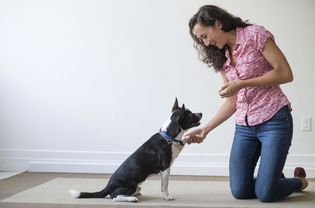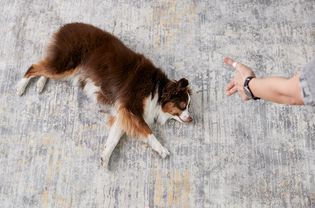Clicker training is a common form of positive reinforcement for dogs. This simple and effective training method utilizes a small device that trainers press to click when the dog shows desired behavior. The click is much faster and more distinct than saying "good dog" and much more effective than training with treats alone.
What Is a Dog Clicker?
A dog training clicker is a metal strip inside a small plastic box that makes a distinct clicking sound when pressed. During training, dogs learn that the sound of the click indicates a positive affirmation, teaching the dog how to continue the good behaviors associated with hearing a click.
To teach a dog the meaning of the click, a treat is given immediately after clicking. Once the dog learns the positive effects of the clicking sound, the clicker itself acts as a conditioned reinforcer. Clickers can be found at most major pet stores and are relatively inexpensive.
Watch Now: How to Clicker Train Your Dog
You can easily train your dog to respond to the clicker. Then you will be able to move on to basic and advanced training. Using a step-by-step training technique is often referred to as "loading" the clicker.
Tie Clicker Training to Rewards
Clicker training is not meant to completely replace the use of treats. The sound of the click instantly tells the dog that what it has done will earn it a reward. To emphasize this, clicks should frequently be followed by treats. Otherwise, the clicker will lose its effectiveness. "While some clicker trainers may not give a reward every time they click, pretty much all clicker trainers continue to follow the click with a reward," trainer Alyssa Walker. "It's very important to use strong rewards a lot during initial training stages, and treats are often the strongest reward for a dog."
The basis of clicker training lies in operant conditioning, which is a scientific term that describes the way animals learn from the consequences of certain behaviors. Positive reinforcement is a type of operant conditioning often used in dog training. Since you will be offering a lot of treats, try to use smaller (but still enticing) treats that your dog enjoys. For an easy, low-cost option, use small pieces of unseasoned cooked turkey or chicken during your training.
Start in a Calm Setting
Begin with your dog in a quiet area without any distractions. Ideally, this training should be done when your dog is hungry. Have a handful of your dog’s favorite treats ready and the clicker in your hand.
Introduce the Clicker
Press the clicker. Immediately upon pressing the clicker, give your dog a treat. Repeat this click/treat combination five to 10 times.
Test Your Dog
You can test your success by clicking when your dog is not paying attention to you. If your dog responds to the click by suddenly looking at you, then looking for a treat, you are ready to move on. If not, continue with the click-treat combination until your dog is aware that every click means a treat.
Click for Basic Commands
Teach your dog basic commands using the clicker. At the exact moment your dog performs the desired action, press the clicker. Follow with a treat and praise. If you don't click at the right time, your dog will be confused and unsure of what action garnered the treat. One of the best things about the clicker is accuracy. The dog associates its action with the click and, subsequently, the reward. Not only does the dog better understand what it is doing, but this also makes your pup more likely to repeat the action when asked in the future.
Move on to Advanced Training With the Clicker
Clicker training can also be very effective for advanced training. "You simply click for small steps toward the behavior and work the dog toward the final, completed behavior," Walker says. "This allows you to be hands-off (except for delivering the reward, of course). You don't need to manipulate the dog into position, which can often slow the process." Overall, the clicker is a very valuable tool in the training process. When creating an obedience and training program for your dog, consider using the clicker and see for yourself how well the method works.
Problems and Proofing Behavior
A common mistake when using the clicker for dog training is to forget the praise. While your dog has been trained to respond to the clicker, it is also following the actions to receive praise from you. Don't ignore a dog's need for praise, love, and affection from its owner. Since clicker training is reward-based, if your dog has a low food-drive or isn't driven by rewards (or treats), this type of training likely won't be effective. Also, if you are using clicker training for more advanced movements or exercises, you need very precise hand-eye coordination and complete attention to click the clicker at the exact time you need. If you aren't able to do this, you will confuse your dog and lead to poor training.
:max_bytes(150000):strip_icc()/jenna-stregowski-tsp-bio-page-300fa370d15f4fb1ae407340bb7ea3ae.png)
:max_bytes(150000):strip_icc()/clicker_training_for_dogs_1118267_2467-482ff314bcba441b81a58537f843ef6a.jpg)






